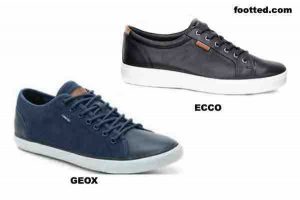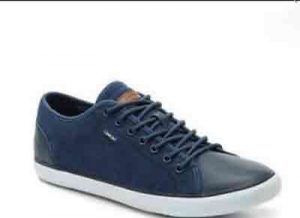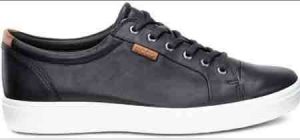Geox is my sure pick between these two. There are so many reasons beyond just its waterproof design and protective nature.
Geox is extremely breathable and one of the most innovative dress shoes in recent times.

I have never liked a lot of shoes. I was born with flat feet. Whenever I wear shoes, they hurt. My hiking shoes are supposed to have good arch support, but they still hurt my feet more than barefoot hiking!
Today, I have a new pair of Geox shoes. Unlike regular hiking shoes, these are lightweight and thin, with a waterproof inner lining and a patented membrane that keeps my feet dry while allowing sweat vapor to escape.
And unlike regular sandals or flip-flops, these provide enough protection against rocks and sticks and thorns to be safe for actual hiking.
I’ve been wearing them on hikes and around town ever since they arrived in May this year. They’re comfortable enough to be my normal everyday shoe.
Geox has got mesh uppers so my toes can spread out and take in air at the same time as my heel is supported by the arch support built into the shoe’s sole.
The breathability makes them cooler than other waterproof shoes I’ve tried, so they don’t make my feet moist.
Similarities between Ecco and Geox

- They both are lace-up system shoes
- They are sports shoes
- Ecco and Geox both have closed-toe box
- They are lightweight shoes
Lace-up system
Shoes with a lace-up system are more preferred than those without them. Both Ecco and Geox shoes consist of great lacing systems which contribute to their brilliant fit.
The reason behind this is very simple; it makes them easy to put on and take off, which is an essential part for kids too. They can also adjust the tightness of their shoe whenever they want to, which is impossible in other types.
Kids like to play around and if they are wearing shoes that are difficult to put on, then you can’t stop them from running out of the house just to do so. This may result in accidents that can be fatal or cause serious injuries.
Also, if you are the very active type, you will be impressed with the flexible lacing on both shoes.
Sport shoes
These shoes are designed for athletic performance. They are typically designed to maximize function (e.g., running speed, jumping height, agility) while minimizing weight and cost.
The main characteristic of these brands is their use of different materials for the upper and the sole.
The upper part of the Ecco is made from a lightweight material, such as mesh or synthetic leather, to reduce weight and allow a closer fit.
The sole is made from a much harder material, such as tough rubber and polyurethane, that allows much better grip and much greater force transfer from foot to the ground.
This design has been adopted by many manufacturers as it allows them to produce a shoe suitable for sports while keeping the price low enough for it to be affordable by most people who take up those sports as a recreational activity.
Geox shoes have been shown to have positive effects on performance in sports requiring sprinting or jumping.
There have been studies investigating whether Geox shoes can improve physical activity and health outcomes in non-competitive populations.
Closed-toe box
Walking around in shoes with closed toe box for extended periods of time is a sure-fire way to get blisters and can lead to other foot problems. The reason is simple; your toes need room to spread and splay and wiggle.
The typical closed-toe shoe, including Eccos and Geox, forces your toes into a cramped position that can cause friction and rub on the top of your toes, sides of your toes, and the tender webbing between your toes.
Thankfully, this friction and abrasion aren’t existent here because of their extra padding.
Do you have to wear shoes that are closed-toe if you want to avoid pain in your feet? I don’t think so. I’ve never worn shoes with a closed-toe box and I feel very comfortable.
I’m not saying that a closed-toe box necessarily causes pain in the feet, but I think the idea that it prevents it is an illusion. And also to highlight the fact that these brands are some of the most functional and most comfortable closed-toe shoes out there.
A closed-toe box doesn’t prevent your toes from getting squashed inside the shoe. A closed-toe box just means that if your toes do get squashed, then there’s no air circulation around them, especially with Geox shoes.
Lightweight
Lightweight shoes like Ecco and Geox are more comfortable than heavier shoes. But they are not just more comfortable for me. They are more comfortable in absolute terms.
Think about it. If you are walking on a sandy beach, how much difference does it make whether you are wearing sneakers or thick-soled boots? Not much. But if you are walking on sharp rocks, every step in some barefoot is going to hurt.
The thin protective gear on the Geox brand can be more protective than the thick protective gear.
More vulnerable tissue gets protected by being put under less pressure. And so with feet: thick shoes press down hard on your feet and push them into the small bones of your foot.
The weight of the Ecco on the other hand, the shoe makes the small bones press against the large bones of your foot, which hurts even if there is no pressure from walking.
Feet get blisters because of pressure, not because of rubbing; the heavier the shoe, the more pressure, and therefore also more blisters.
Differences between Ecco and Geox

| S/NO | Features | Ecco | Geox |
| 1 | Design | Comfort | Protection |
| 2 | Soles | Balanced soles | Grippy soles |
| 3 | Grooves | Smaller grooves | Large grooves |
| 4 | Material | Padded | Breathable |
| 5 | Product variation | Canvas uppers | Waterproof membrane uppers |
Related topics:
Different Design
Some people want their shoes to be comfortable, and other people want their shoes to be protective. If you are in the latter group, you might think people who care only about comfort are irresponsible, but they aren’t.
For me, Ecco is what you need when you are sitting around doing nothing. What you need when you are doing something else is Geox shoes.
For example, hiking boots provide protection against rocks and sticks and awkward terrain. But they can also be uncomfortable after a few hours of walking.
So, if you are taking a long hike, it is good to bring along your Geox for better comfort during demanding activities. If you are not taking a long hike, it is better to wear your Ecco shoes instead of your Geox.
If you have a job where you have to spend most of your time on your feet, there is a difference between comfort and protection.
Comfort means a good fit, low weight, and a soft sole like your Eccos. Protection means steel toes and a slip-resistant tread like Geox.
The problem with comfort is that it doesn’t protect you from injury if you happen to step on the wrong thing.
The problem with Geox here is that it is sturdier and makes the shoe more rigid, which can lead to discomfort even when breathable.
Different soles
Balanced soles and Grippy soles are different, and we should be able to measure at least some of the differences. We can only do this if we can define what we mean by a “shoe sole.”
Both Ecco and Geox look the same, no doubts. They fit roughly the same too, and their surfaces are similarly textured.
There is nothing that sticks out that could be called a major difference (except Geox’s obviously larger grooves); there is no separate layer of rubber or anything like that.
The difference is in what happens when you step on them. In one of my experiments, I noticed some strengths with Geox shoes here;
When you walk on a surface like a wooden floor with Eccos, your foot slides relative to the floor as you step forward.
If the floor were absolutely smooth, the Geox would slide without friction, but instead, it has little irregularities with Eccos, which cause frictional forces as your foot moves.
Different Grooves
In a pair of shoes with large sole grooves, the bottom of the foot has more contact with the ground. In a pair of shoes with small sole grooves, the bottom of the foot has less contact with the ground.
I have observed that there are two kinds of sole grooves which shoes can have. The first type is the kind on Eccos, which is flat, well-trimmed, and shallow; the second type on Geox shoes is the kind that is deep and wide.
These two different types of sole grooves are quite different to walk in. If you take a step for the first time with Ecco shoes’ sole grooves, then you will feel almost nothing.
But if you take a step normally with the kind of sole grooves on Geox shoes, then there will be some balance to get used to.
To further explain this difference between large and small sole grooves, I will use the following analogy:
Suppose there are two different types of screws. You might call them “shallow” screws and “deep” screws.
Shallow screws are just barely long enough to sink into the surface they are screwing into; deep screws go all the way in.
With Geox shoes:
- The sole is thicker and stronger, and better able to protect the foot.
- Less balanced but more grippy.
- You can’t feel things as well with your foot.
With Ecco shoes:
- You can feel things better with your foot.
- Better control.
- Less grippy and more balanced.
Materials
The main difference between them in terms of material lining is the material used to make them.
Ecco shoes are made from synthetic fabrics such as polyester, spandex, nylons, cotton, canvas, and other fabrics that may be woven or knitted.
Breathable shoes, on the other hand, are made from natural fabrics such as membrane fabric and other waterproof products.
Eccos can last longer than Geox shoes because it is sturdier and more durable even though the latter can also provide warmth during winter months due to its orthotic-like finishing.
Furthermore, Geox shoes tend to be more protective than Eccos because of their thicker soles and sophisticated uppers.
Geox shoes can allow for better foot ventilation because of their sole. It can be worn by those who have sweaty feet as well as those who don’t like it too warm on their feet since this type of material allows air circulation.
This type of shoe has a more flexible fit compared to Eccos since it is made from fabric while padded shoes usually come with natural protectors.
Product variation
Eccos are usually made of canvas, PVC, and other traditional materials used in making shoes. Most have woven fabric made from cotton, linen, or synthetic fibers. They are flexible and durable. However, they are not waterproof.
Geox footwears feature uppers made by sandwiching a waterproof material between two layers of canvas or leather. The waterproof material is made from polyvinyl chloride (PVC) or polyurethane (PU).
These shoes can be made in any style and color you like. However, they are not as durable as traditional shoes and they may feel hard on your feet at first. But most people get used to them almost immediately.
Related topics:
Conclusion
Eccos and Geox shoes are different and can be categorized as such. They both have their own pros and cons; it is all up to you to decide which one is more suitable for your type of feet.
There are probably optimal choices for different kinds of jobs, but all jobs involve some compromise between comfort and protection.
When I worked as a roofer, my Geox shoes were patented membrane fabric with steel toes and a slip-resistant tread, but they had a soft sole, no hard shank because I was climbing around on roofs all day.
When I worked as a programmer, I was sitting down all day. The downside of the Ecco here is the softer uppers where I occasionally stubbed my toe when I got up in the middle of the night to go to the bathroom.
The upside though, was that the shoe didn’t hurt my foot even when I was working.
This page may contain affiliate links.
To support the content and the knowledge I share here, I earn from qualifying purchases from Amazon at no extra cost to you.
